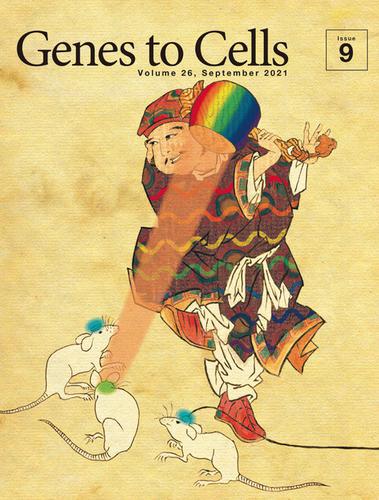当前位置:
X-MOL 学术
›
Genes Cells
›
论文详情
Our official English website, www.x-mol.net, welcomes your
feedback! (Note: you will need to create a separate account there.)
Issue Information
Genes to Cells ( IF 1.3 ) Pub Date : 2021-09-09 , DOI: 10.1111/gtc.12787
Genes to Cells ( IF 1.3 ) Pub Date : 2021-09-09 , DOI: 10.1111/gtc.12787

|
Front cover: Advances in optogenetic techniques, in which light-activated proteins that respond to specific wavelengths are expressed in specific cells, have made it possible to manipulate the activity of specific nerves in many animal species including mammals with high temporal and spatial precision. The method of using optical fiber for light irradiation (right) is highly invasive and restricts behavior of animal. However, new methods to overcome this problem have emerged. Some examples are a method of using implantable wireless light-emitting devices (top left), and a method of injecting upconversion nanoparticles that emit visible light in response to near-infrared (NIR) lights that reach deep into the body (center; the light emitted from Uchideno-kozuchi (magic mallet) of Daikokuten is NIR). Designed by TRAIS Co., Ltd. (Kobe, Japan).

中文翻译:

问题信息
封面:光遗传学技术的进步,其中响应特定波长的光激活蛋白在特定细胞中表达,使得在许多动物物种(包括哺乳动物)中以高时间和空间精度操纵特定神经的活动成为可能。使用光纤进行光照射的方法(右)具有高度侵入性并限制了动物的行为。然而,已经出现了克服这个问题的新方法。一些例子是使用植入式无线发光设备的方法(左上),以及注射上转换纳米粒子的方法,这些纳米粒子发射可见光以响应到达身体深处的近红外 (NIR) 光(中心;光从 Daikokuten 的 Uchideno-kozuchi(魔法槌)发出的是 NIR)。由 TRAIS Co., Ltd.(日本神户)设计。

更新日期:2021-09-09

中文翻译:

问题信息
封面:光遗传学技术的进步,其中响应特定波长的光激活蛋白在特定细胞中表达,使得在许多动物物种(包括哺乳动物)中以高时间和空间精度操纵特定神经的活动成为可能。使用光纤进行光照射的方法(右)具有高度侵入性并限制了动物的行为。然而,已经出现了克服这个问题的新方法。一些例子是使用植入式无线发光设备的方法(左上),以及注射上转换纳米粒子的方法,这些纳米粒子发射可见光以响应到达身体深处的近红外 (NIR) 光(中心;光从 Daikokuten 的 Uchideno-kozuchi(魔法槌)发出的是 NIR)。由 TRAIS Co., Ltd.(日本神户)设计。












































 京公网安备 11010802027423号
京公网安备 11010802027423号